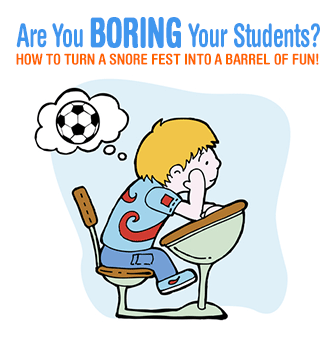ESL Alert! Do You Make These Mistakes When Teaching English?


Finally, to add insult to injury, another student is watching a video on their iPod. If there were a sign over your classroom door, it would read “Entering Dullsville.”
While the above description is clearly an exaggeration, every ESL teacher at some point in their teaching career has had to deal with unmotivated students, boring course material or quite honestly been bored themselves with what they have to teach. So, hop onto our express train and leave Dullsville for good!

When there is something that you don’t like to teach, whether it’s the Past Perfect, or Reported Speech, or any other grammar point you absolutely must cover, your students will most likely notice it, unless you do something about it and make the topic fun for the whole class. If you have taught something a million times, like the Past Simple, teach it differently every time! Use different flashcards, different exercises, different games, just make sure there is something different, that way it is less likely you will feel bored and by extension neither will your students.
Kids love it when you pull something crazy, but teens and adult learners also enjoy seeing things that they wouldn’t normally see in a classroom. Say you want to practice making predictions with “will”. What if you were to suddenly put a crystal ball on the table and tell students what the future holds for them? Your crystal ball need not be made of crystal – a volleyball or even a balloon will do, and add to the zaniness. Crazy props are very effective in engaging students.
While you’re not required to go into full costume (after all you’re teaching ESL, not putting on a Broadway show!) it does help tremendously to do voices, make faces, and show off your more theatrical side. Do accents and change voices when you read dialogues, or even use funny characters – give them your best Eliza Doolittle impersonation and show off your Cockney accent as your students do a shopping role play with you!
The second you see your students settle in for a nap, make them stand up! Young learners can engage in an active TPR activity. But don’t be afraid to get adults out of their seats, as well. Make them walk around the classroom for a role play, or simply get them to come to the whiteboard. You may need a bulldozer to get some teens out of their seats, so try with small actions first, like handing out worksheets, then gradually move on to a greater physical commitment. It is essential that you make your students get used to moving around the classroom from Day 1.
Get your students used to not knowing what you’ll do next. Sit down for one activity, but then stand up or walk around the room for the next – walking from the front to the back is also the perfect way to let students know that the back of the room is not the place to snooze. Raise your voice suddenly! Change pitch! Clap your hands to get their attention! Use gestures as much as you can, and use sounds to keep them alert. A quiet classroom where the teacher sits at her/his desk for the duration of the class is the perfect setting for a snore fest.
You wouldn’t talk about President Obama’s foreign policy with preschoolers, right? And with that kind of topic, you won’t hold your teens’ attention for long. But don’t make the mistake of thinking that all adults like to talk about “adult” things! They come to ESL class to learn English, not for a history lesson. However, some adults may be interested in business topics or current events. So, make sure you find out what they are really interested in and what their preferences are. Do they want to learn English in a relaxed environment, or they want to talk business?
Quite often the problem is not us or our students, but the rather dull coursebook. You will probably agree that there is no one pointing a gun to your head, saying that you have to follow the book and each activity as shown in the book, right? One of the best things you can do is adapt and change some of the activities, dialogues and exercises in the coursebook, or replace them with others that will get the job done, but not put your students to sleep in the process.
You’re headed to a much better place, one that will provide the perfect learning environment for your students – and keep them engaged for the duration of the course.
Giving students fun, engaging lessons – that’s what BusyTeacher.org is all about! If you have any tips for making lessons less dull and more fun, please share them below!